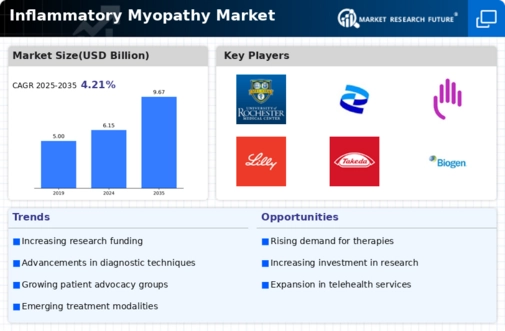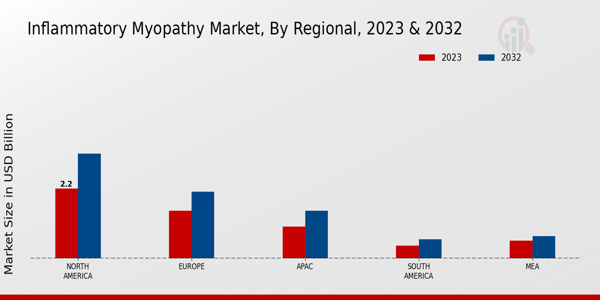Market Growth Projections
The Global Inflammatory Myopathy Market Industry is projected to experience substantial growth in the coming years. By 2024, the market is anticipated to reach 6.15 USD Billion, with expectations to expand to 9.67 USD Billion by 2035. This growth trajectory reflects a compound annual growth rate of 4.2% from 2025 to 2035, indicating a steady increase in demand for therapeutic interventions and healthcare services. The market dynamics are influenced by various factors, including advancements in treatment options, increased awareness, and the rising prevalence of inflammatory myopathies.
Advancements in Treatment Modalities
Innovations in treatment modalities are significantly influencing the Global Inflammatory Myopathy Market Industry. The development of targeted therapies and biologics has transformed the management of inflammatory myopathies, offering patients more effective and personalized treatment options. These advancements not only improve patient outcomes but also enhance the quality of life for individuals affected by these conditions. As the market evolves, the introduction of new therapies is expected to propel the market value, potentially reaching 9.67 USD Billion by 2035, indicating a robust growth trajectory.
Expansion of Healthcare Infrastructure
The expansion of healthcare infrastructure globally is playing a pivotal role in shaping the Global Inflammatory Myopathy Market Industry. Improved access to healthcare facilities and specialized services enhances the ability to diagnose and treat inflammatory myopathies effectively. This expansion is particularly evident in emerging economies, where investments in healthcare are increasing. As healthcare systems evolve and become more capable of managing complex conditions, the market is expected to benefit from a larger patient base seeking treatment, thereby contributing to its overall growth.
Rising Prevalence of Inflammatory Myopathy
The Global Inflammatory Myopathy Market Industry is witnessing a notable increase in the prevalence of inflammatory myopathies, which include conditions such as dermatomyositis and polymyositis. This rise is attributed to various factors, including an aging population and improved diagnostic techniques. As of 2024, the market is projected to reach 6.15 USD Billion, reflecting the growing awareness and recognition of these diseases. The increasing incidence rates are likely to drive demand for innovative treatment options and healthcare services, thereby contributing to the overall growth of the market.
Growing Awareness and Education Initiatives
There is a growing emphasis on awareness and education initiatives surrounding inflammatory myopathies, which is positively impacting the Global Inflammatory Myopathy Market Industry. Healthcare organizations and advocacy groups are actively working to educate both healthcare professionals and the public about these conditions. Increased awareness leads to earlier diagnosis and treatment, which can improve patient prognosis. As more individuals become informed about the symptoms and available treatments, the demand for healthcare services and interventions is likely to rise, further driving market growth.
Increased Research and Development Activities
The Global Inflammatory Myopathy Market Industry is benefitting from increased research and development activities aimed at understanding the underlying mechanisms of inflammatory myopathies. Government and private sector investments in research are fostering the discovery of novel therapeutic targets and biomarkers. This focus on R&D is crucial for developing effective treatments and improving diagnostic accuracy. The anticipated compound annual growth rate of 4.2% from 2025 to 2035 underscores the potential for significant advancements in the field, ultimately enhancing patient care and outcomes.

























